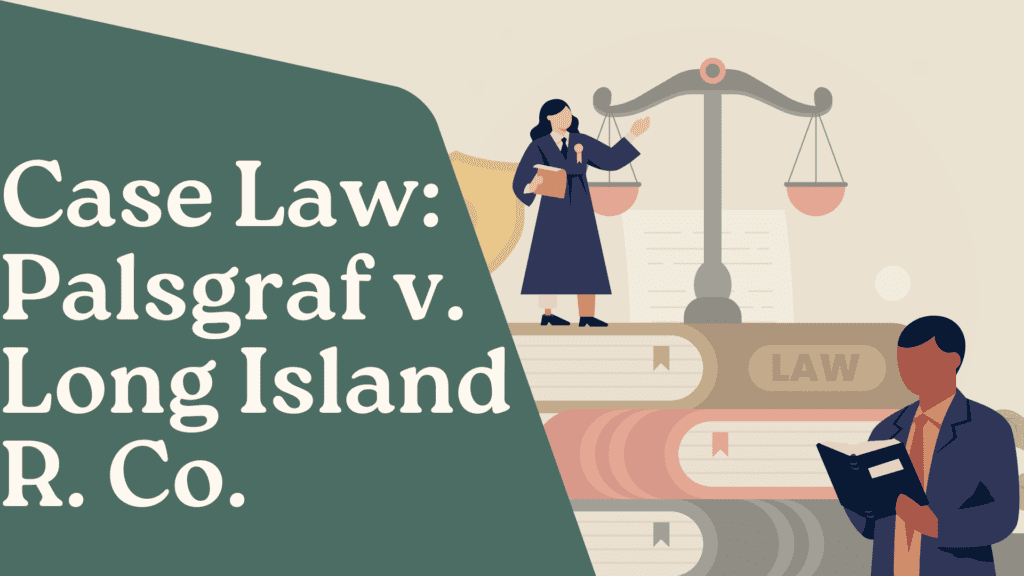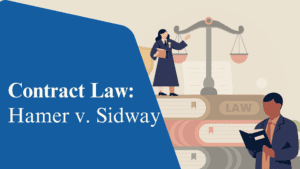
In the annals of legal history, certain cases stand out as turning points that reshape the legal landscape. Palsgraf v. Long Island R. Co. is undoubtedly one such case. Decided by the New York Court of Appeals in 1928, this landmark case not only established important principles of tort law but also sparked a broader discussion on the limits of liability and causation. Let’s delve into the details of this influential case and explore its enduring impact on the legal system.
Background:
On the afternoon of August 24, 1924, Helen Palsgraf, a passenger waiting on the platform of a Long Island Rail Road (LIRR) station, became an unwitting participant in a legal drama that would captivate legal scholars for years to come. As a train employee assisted a passenger onto a departing train, a package fell from the passenger’s hands, containing fireworks. The fireworks exploded upon impact, causing scales at the other end of the platform to fall, injuring Palsgraf.
The Legal Battle:
Helen Palsgraf filed a lawsuit against the LIRR, seeking compensation for her injuries. The central issue in the case was whether the railroad company could be held liable for harm caused by an event seemingly unrelated to their actions. The court’s decision would set a precedent for the concept of proximate cause, which determines the extent to which a party can be held accountable for damages.
Proximate Cause and Foreseeability:
In its ruling, the New York Court of Appeals held that the LIRR could not be held liable for Palsgraf’s injuries. The court reasoned that the actions of the railroad employees were not directly responsible for the harm suffered by Palsgraf. They concluded that the chain of events leading to her injuries was unforeseeable, given the circumstances at hand.
Judge Benjamin Cardozo, writing for the majority, outlined the principle of proximate cause as follows: A defendant can only be held liable for the foreseeable consequences of their actions. In this case, the court found that the injury to Palsgraf was not a foreseeable result of the LIRR’s employees helping the passenger onto the train.
Impact and Legacy:
Palsgraf v. Long Island R. Co. had a far-reaching impact on the development of tort law. The case shifted the focus of liability from the mere occurrence of harm to the concept of foreseeability. It emphasized the need for a direct connection between the defendant’s actions and the plaintiff’s injuries, setting a precedent for the establishment of proximate cause in future cases.
Moreover, Palsgraf sparked a broader debate within legal circles regarding the limits of liability. It raised fundamental questions about causation, highlighting the complexities of determining legal responsibility in cases involving remote or unforeseeable consequences. The case continues to be extensively studied in law schools and serves as a foundation for legal reasoning in the realm of tort law.
Conclusion:
Palsgraf v. Long Island R. Co. remains a pivotal case in the evolution of tort law. By introducing the concept of proximate cause and emphasizing the need for foreseeability, it laid the groundwork for future decisions and established important principles for determining liability. As legal scholars and practitioners continue to analyze its implications, this landmark case continues to shape the way we understand and apply tort law today.
The Continuing Debate and Modern Applications
In the nearly a century since the Palsgraf v. Long Island R. Co. decision, the principles established by the court continue to be a subject of intense debate and interpretation. Legal scholars and practitioners have explored various aspects of the case, addressing its implications in a rapidly evolving legal landscape.
One area of ongoing discussion pertains to the concept of foreseeability. While the court in Palsgraf determined that the injury suffered by Helen Palsgraf was unforeseeable, subsequent cases have grappled with defining the boundaries of what is reasonably foreseeable in different circumstances. Courts have sought to strike a balance between holding defendants accountable for reasonably foreseeable consequences while avoiding an overly expansive scope of liability.
Additionally, the case’s application has extended beyond traditional tort law. The principles of proximate cause and foreseeability have been invoked in various branches of law, including product liability, medical malpractice, and negligence claims. Palsgraf’s influence is particularly evident in cases involving complex systems, such as those concerning technology, transportation, and public safety, where understanding the direct causal relationship between an act and its consequences becomes crucial.
Furthermore, as society continues to evolve, new questions and scenarios arise that challenge the boundaries set by Palsgraf. The rise of digital platforms and the interconnectedness of the modern world present unique challenges in determining foreseeability and proximate cause. Courts must grapple with issues of cyber liability, data breaches, and emerging technologies, as well as the potential for remote and cascading consequences.
In response to these developments, legal scholars and courts have explored alternative approaches to liability. Some argue for a more flexible and context-specific interpretation of foreseeability, considering factors such as the defendant’s knowledge, the nature of the risk, and societal expectations. Others propose a more expansive view of proximate cause, focusing on the overall fairness and justice of holding a defendant accountable, even in cases with unforeseeable consequences.
Ultimately, the ongoing debate surrounding Palsgraf v. Long Island R. Co. reflects the dynamic nature of the law. The case has acted as a catalyst for critical analysis and discussion on the fundamental principles of tort law. While the decision itself provides a foundation, its application and interpretation in modern contexts continue to evolve, guided by a desire for fairness, justice, and the appropriate allocation of liability.
In conclusion, Palsgraf v. Long Island R. Co. remains a touchstone case in the realm of tort law. Its enduring legacy lies not only in the specific principles it established but also in the ongoing debate and interpretation it has sparked. As the legal system grapples with complex and novel scenarios, the principles of proximate cause and foreseeability continue to shape the way liability is determined, adapting to the changing dynamics of a rapidly evolving society.
Disclaimer: The legal content provided on this blog is intended for educational and study purposes only. While efforts have been made to ensure accuracy, please note that the information presented here is generated with the assistance of artificial intelligence (AI) and may not always be accurate or up-to-date. This content should not be considered as a substitute for professional legal advice. Laws and regulations vary by jurisdiction and are subject to change. Readers are encouraged to consult with qualified legal professionals or authoritative sources to obtain accurate and current legal information tailored to their specific circumstances. The blog owners, authors, and contributors do not assume any responsibility or liability for any inaccuracies, errors, or omissions in the content provided. By accessing and using this blog, you acknowledge and agree that any reliance on the information presented herein is at your own risk.
